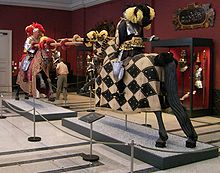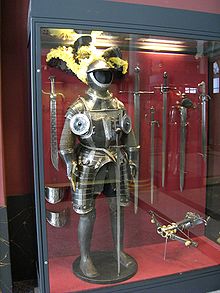Armory (Dresden)

The armory in Dresden , also known as the "Historisches Museum Dresden" since 1831, is part of the Dresden State Art Collections and is one of the world's most important collections of splendid weapons, armor and historical textiles. Up until the 1830s, the armory was not used as an art collection, but primarily for the electoral representation. It was not until the 1920s, after the abolition of the Saxon monarchy, that the collection acquired its significance in terms of art history.
The armory was located in the Sempergalerie of the Zwinger until the end of September 2012 . The armory in the giant hall of the Dresden Residenzschloss has been open to the public since February 19, 2013 .
The Ottoman part of the armory, the Türckische Cammer , has been on view as a permanent exhibition in the Dresden Residenzschloss since 2010.
history


The origin of the armory goes back to Albrecht the Courageous . With the partition of Leipzig in 1485, he had received an independent duchy. He then founded a ducal armor chamber in the Dresden residential palace . With the assumption of the Saxon electoral dignity by Duke Moritz in 1547, the electoral armory and armor chamber emerged. It was used to store the court's body weapons, tournament weapons and ceremonial weapons and the associated equipment and was also located in the residential palace.
Elector August von Sachsen did not begin to collect objects of art until the 16th century. Under his leadership, the Electoral Armory and Harness Chamber and the Hunting Chamber were merged to form the Electoral Armory . He also initiated the museum era for this collection. The oldest total inventory dates from 1567 and lists over 1,500 weapons. Many harnesses were already on carved wooden horses. August von Sachsen obtained the financial means for the growing collection mainly from silver mining in the Ore Mountains and the dissolution of monasteries and churches after the Reformation, as well as the flourishing crafts, trade and the flourishing Saxon agriculture at the time. Some pieces were also gifts for the electoral court. In addition, numerous armourers , armourers , gunsmiths , goldsmiths and cutlers worked at the Saxon court. The Dresden armory and armor chamber in the 16th century was similar in size to the Imperial Armory in Vienna.
The collection was greatly expanded under Christian I and his successor Christian II , and valuable pieces by German, Italian, French and Spanish masters were added. In 1591 the armory moved into the upper floors of the recently built stable building (today's Johanneum), where it remained until 1772.
Johann Georg I expanded the collection primarily with hunting weapons and equipment. Johann Georg III. added oriental weapons. He had brought these as spoils of war from the battle with the Turks outside Vienna in 1683. However, the collection was only insignificantly expanded between Johann Georg I and Johann Georg IV .
Elector August the Strong also showed little interest in collecting armaments and weapons. However, with the appointment of August as King of Poland in 1697 , the armory gained royal status. However, when August took over this office, he was faced with great demands for representation. The stable building was intended for the collection of paintings, which meant that the armory had to move to the neighboring “Secret War Chancellery” in 1722. August the Strong also moved the richly decorated swords and other magnificent weapons from the armory to the " Green Vault " treasury museum, which was created between 1723 and 1729 . Important collector's items from the time of August the Strong are the sword of Peter the Great and the coronation regalia that August the Strong wore when he was coronated as King August II of Poland in 1697.
The successor to August the Strong, August III. , had an extensive collection of firearms built in the “Long Hall” of the stable yard , the rifle gallery. With 3,000 pieces, the collection now represents an important part of the art objects in the armory.
In 1831 the armory came under state administration and was now called the Royal Historical Museum. A year later the exhibition was moved from the "Secret War Chancellery" to the Zwinger . To finance the move, numerous objects from the collection were sold, which significantly reduced the holdings of the armory. Another move took place in 1877, so the Historical Museum was again housed in the Johanneum . It stayed here until it was relocated during World War II . The ceremonial weapons from the armory, which August the Strong had recalled around 1728, were brought back here from the Green Vault between 1913 and 1914.
During the Second World War, the works of art were moved to the Königstein Fortress and several Saxon castles. After the war, the Soviet occupation forces brought the collection to Leningrad . In 1958, Dresden received the collection back. In 1959 the first exhibition opened in the east wing of the Sempergalerie at the Zwinger . The museum , which was renamed Armory in 1992, was located here until September 2012.
Since February 19, 2013, the armory has been open to the public again in the giant hall of the Dresden Palace . Created in 1480 as the central hall of the residence, the giant hall, which was built in the 16th century in its current dimensions, is almost 60 meters long and 13 meters wide and is the largest and most famous room in the palace.
Holdings and exhibition
The armory includes historical weapons, clothes, armor and portraits from the 15th to 18th centuries . The entire collection contains around 10,000 works of art, made by goldsmiths and armourers , artisans , painters and courtly costume makers from all over Europe. The main focus of the collection is on cutting and stabbing weapons with around 2,200 swords , rapiers and daggers, as well as historical firearms , consisting of around 1,400 pistols and 1,600 rifles.
Today around 1,300 objects, less than 10 percent of the inventory, are shown in a modern exhibition using 121 showcases. The exhibits cover the period from the 15th to the 18th century, including art chamber pieces, ceremonial weapons - armor, helmets, shields, swords, rapiers and daggers, sabers, pistols and rifles - as well as riding gear, ceremonial clothing and portraits from the possession of the Wettin electors. One of the exhibits is the crown of August II.
From the inventory of almost 1000 oriental or orientalizing objects in the armory, over 600 exhibits are on display in the Türckische Cammer .
See also
Web links
- The armory at the Dresden State Art Collections
- Literature on the armory in the catalog of the German National Library
Individual evidence
- ↑ Homepage Staatliche Kunstsammlungen Dresden Rüstkammer , accessed on February 28, 2018
- ↑ a b c Jutta Bäumel: armory . Munich: Deutscher Kunstverlag, 2004, ISBN 3-422-06417-6 , pp. 9-10
- ↑ a b Jutta Bäumel: armory . Munich: Deutscher Kunstverlag, 2004, ISBN 3-422-06417-6 , p. 16
- ↑ Jutta Bäumel: armory . Munich: Deutscher Kunstverlag, 2004, ISBN 3-422-06417-6 , p. 19
- ↑ a b Jutta Bäumel: armory . Munich: Deutscher Kunstverlag, 2004, ISBN 3-422-06417-6 , p. 21
Coordinates: 51 ° 3 ′ 9.2 " N , 13 ° 44 ′ 14.8" E

